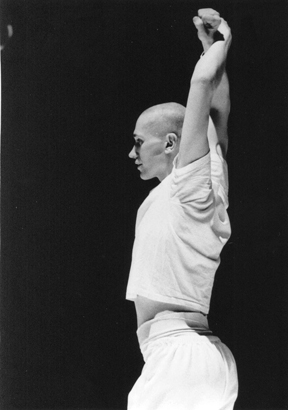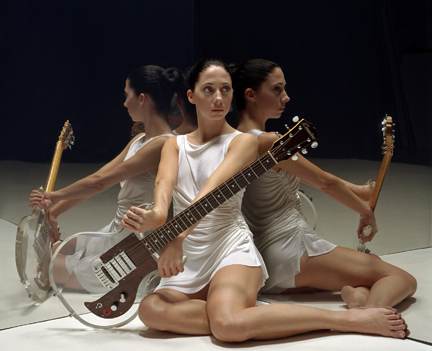Half and Half
“O”
Michael Clark Dance Company
Barbican Theatre, London
November 1 – 5, 2005, and touring January – March 2006
by John Percival
copyright ©2005 by John Percival
 I was amused by the number of writers who used the word comeback apropos this production. Michael Clark actually “came back” seven years ago. Let me remind you of his tumultuous life story as an amazingly gifted dancer and highly original choreographer:
I was amused by the number of writers who used the word comeback apropos this production. Michael Clark actually “came back” seven years ago. Let me remind you of his tumultuous life story as an amazingly gifted dancer and highly original choreographer:
1979: Aged 17, had a leading role created on him by his teacher at the Royal Ballet School, but refused a contract at Covent Garden and instead joined Rambert Dance where Richard Alston made several roles for him. Danced also with other small companies in Britain, America and France (including Karole Armitage’s), and began showing work of his own at Riverside Studios in west London, then a centre of new dance.
1984: Started his own company with two wonderfully inventive dances, “Do You Me? I Did” and “New Puritans”, featuring the redoubtable Matthew Hawkins to rival his own dancing. Nureyev saw that show and asked Clark to choreograph for the Paris Opera — the first of several major companies including Scottish Ballet, London Festival Ballet, Rambert and the Deutsche Oper Berlin. For his own company he made increasingly large works with an important visual element (much influenced by his friend and collaborator Leigh Bowery) and usually with major rock bands. But he also made acclaimed shows incorporating Stravinsky’s “Rite of Spring” and “Apollo”.
1994-98: Took four years off, living with his mother in Scotland, reportedly to overcome the effects of heavy drug use.
1998: Returned to making pieces for his own groups, also creating for Baryshnikov and others, becoming an artistic associate of the famed Barbican Centre in the City of London, and won the Olivier Award for best new dance production with a reworking of “Swamp” for Rambert Dance. His work has been the subject of no fewer than three television documentaries—a rare privilege.
 His new production, “O”, commissioned by the Barbican, begins a three-year Stravinsky project with the theatre (and is co-produced by Clark’s company, the Young Vic, Dance Umbrella, Festival de Marseille, Seoul Performing Arts and Danceworks UK – quite a line-up!) In the first act, Clark triumphs with a return to the elegant inventiveness of his early choreographic style. The success of his dances is the more remarkable because the members of his new company (three women, four men) are less good than the teams he assembled in those early days. The piece develops from a very simple beginning of walks, leaning poses or leg extensions, to become gradually more complex and to demand more classical technique. And as it goes on the dancers, especially the men, prove less able to cope. Clark’s own appearances, carrying a transparent walking cane (a neat joke, I think), although mostly brief and rather simple, reveal a sheer quality of movement that outclasses everyone else on stage. This half is accompanied by rowdy, over-amplified rock music by Iggy Popp and Wire.
His new production, “O”, commissioned by the Barbican, begins a three-year Stravinsky project with the theatre (and is co-produced by Clark’s company, the Young Vic, Dance Umbrella, Festival de Marseille, Seoul Performing Arts and Danceworks UK – quite a line-up!) In the first act, Clark triumphs with a return to the elegant inventiveness of his early choreographic style. The success of his dances is the more remarkable because the members of his new company (three women, four men) are less good than the teams he assembled in those early days. The piece develops from a very simple beginning of walks, leaning poses or leg extensions, to become gradually more complex and to demand more classical technique. And as it goes on the dancers, especially the men, prove less able to cope. Clark’s own appearances, carrying a transparent walking cane (a neat joke, I think), although mostly brief and rather simple, reveal a sheer quality of movement that outclasses everyone else on stage. This half is accompanied by rowdy, over-amplified rock music by Iggy Popp and Wire.
In Act Two, however, Clark himself is outclassed by Stravinsky’s score for the ballet “Apollo”, and by memories (ours and his too, I would guess) of Balanchine’s superb choreography to it. Structurally, Clark partly copies this, but not in technique or drama, and at a far less inspired level. He himself danced memorably to parts of this score 11 years ago, but no longer appears in it, and Ashley Chen, the most prominent — and best — of his new men, isn’t in his class (although trained at the Paris Conservatoire and having danced for Merce Cunningham). Kate Coyne and Melissa Hetherington are the featured women, OK but nothing more.
The real hero of this half is the conductor Robin Ticciati, only 22 (and looking even less), who this summer became the youngest person ever to conduct at La Scala, Milan, with a programme of Brahms and Elgar. London born and Cambridge trained, he already has contracts in Dresden, Glyndebourne, Gothenburg, Liverpool, Salzburg, Stuttgart and more. He wins an entirely beautiful account of the music from the string players of the newly formed Aurora Orchestra. Pace, rhythm and flow are all quite exceptional; we haven’t often heard the score played nearly as well even by much more experienced musicians. Too bad that the production’s later tour will have to use recorded music.
The total effect seems markedly different from Clark’s previous treatment of “O” eleven years ago. Settings by Clark and Steven Scott are simple and ingenious, costumes by Stevie Stewart and Clark are handsome and simple too; Charles Atlas’s lighting is excellent.
Volume 3, No. 41
November 7, 2005
copyright
©2005 John Percival
www.danceviewtimes.com
|
|